AMD Announces Carrizo and Carrizo-L, Next Gen APUs for H1 2015
by Ian Cutress on November 20, 2014 5:45 PM EST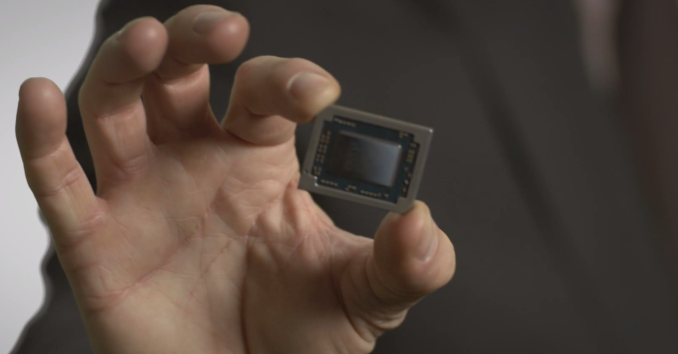
Today AMD is announcing the long anticipated upgrade to Kaveri, codenamed Carrizo. Carrizo is the natural successor to Kaveri, featuring x86 ‘Excavator’ cores alongside a Radeon-class GPU and promising an increase in performance all around. The second part of today’s announcement is for Carrizo-L, an SoC pairing “Puma+” (upgraded Beema) cores also with AMD’s R-series GCN GPUs and a FCH into a single package. Both Carrizo and Carrizo-L will feature ARM Trustzone, giving potential hardware-based built-in security when used by developers.
The Excavator cores are an architectural improvement over Steamroller, but are fundamentally based on the original Bulldozer concept. Excavator will be AMD’s fourth iteration of the concept, following Bulldozer, Piledriver and Steamroller. This new generation of APUs are still set to be built on the 28nm Super High Performance process at Global Foundries, delaying AMD’s shift to 20nm, but AMD are still claiming that the new GPU in Carrizo is their best yet, giving better performance and efficiency than before.
Given AMD's discrete GPU lineup, the GPU for Carrizo could be based on AMD's latest GCN 1.2 architecture, which was first introduced in the desktop Tonga part earlier this year. GCN 1.2's lossless delta color compression algorithms help improve the performance in memory bandwidth limited scenarios, such as in APUs. This could result in a bigger-than-expected jump in performance, although we will wait until we can test to find out how much it helps.
The Carrizo platform will be fully HSA 1.0 compliant, compared to Kaveri which only had ‘HSA Features’, as AMD puts it in their latest mobility roadmap update:
The push from AMD into HSA compliant APUs was well documented back at the launch of Kaveri earlier this year. This enabled the CPU and GPU components of the silicon, while under OpenCL 2.0 mode, to have access to the main block of system DRAM with zero-time copy functions, offering the potential for large classes of applications especially those in the prosumer and industry space to be accelerated by having instant access to the parallelization afforded by the GCN GPU. One of the big drawbacks of being an earlier adopter to HSA, as we noted at the time, was that software developers required time to bring their code to market, as well as AMD having to go out and teach the developers how to cater for HSA topology.
Both Carrizo and Carrizo-L on the mobile side will be targeted at the same power bands as Kaveri and Beema, although the socket will be new. The use of FP4 BGA also indicates that a single socket will cater for both the Excavator and Puma+ based APUs and would be interchangeable. A video by AMD’s VP/GM for Computing and Graphics, John Byrne, states that Carrizo and Carrizo-L are currently being tested internally ready for a 1H 2015 release, along with support for DirectX 12, OpenCL 2.0, Mantle and Freesync.
One of the big features that AMD is pushing with Carrizo is energy efficiency, with it being a keystone of the message. Because AMD have been on the same process node for a short while, they have to essentially follow the Maxwell example, by providing more performance for less power without the advantage of shrinking resistors. We were provided with an energy efficiency roadmap as well, showing the different methods AMD is using to achieve this:
One example of the efficiency improvement was provided by AMD’s Voltage Adaptive Operation. Rather than compensate for voltage variations which wastes energy, this technology takes the average operating voltage and detects when the voltage increases beyond a smaller margin. To compensate for this increase, the CPU speed is reduced until the voltage drops below the threshold and then the CPU speed is moved back up.
The changes in speed are designed to be so minute that it does not affect overall performance, however it might only take an errant voltage delivery component to consistently make the voltage go above that threshold, causing erratic slowdown that might be statistically significant. It will be interesting to see how AMD implements the latest version of this feature.
The 2015 desktop roadmap remains unpublished so far. AMD’s perception of a mobile-focused strategy would tend to suggest that the mobile comes first, with desktop following behind, although at this point it is unclear. A number of AMD’s marketing materials with this launch gave examples of the use of Carrizo and HSA for the prosumer, indicating that a desktop version should be announced in due course.
As of yet there was no discussion on the APUs to be launched, the speeds or the capabilities. All the roadmap tells us is 'up to four cores' (Excavator for Carrizo, Puma+ for Carrizo-L), some GCN compute units and 10-45W overall. There is no mention of DDR4 support, although the timeframe might be relevant for AMD to make the jump. Given the launch is still at least two quarters away, I would expect better details in due course. That timeframe fits in nicely around or just after Computex, perhaps indicating more details then.
Source: AMD


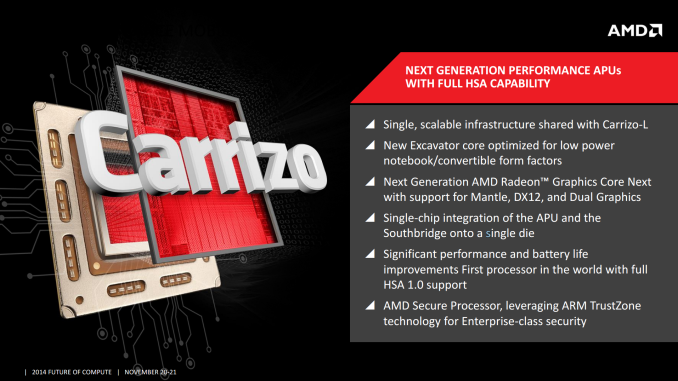
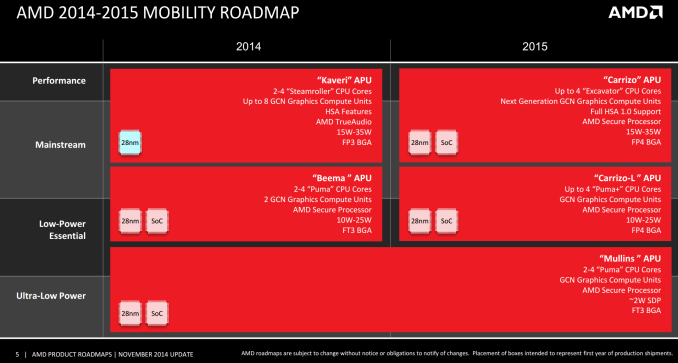
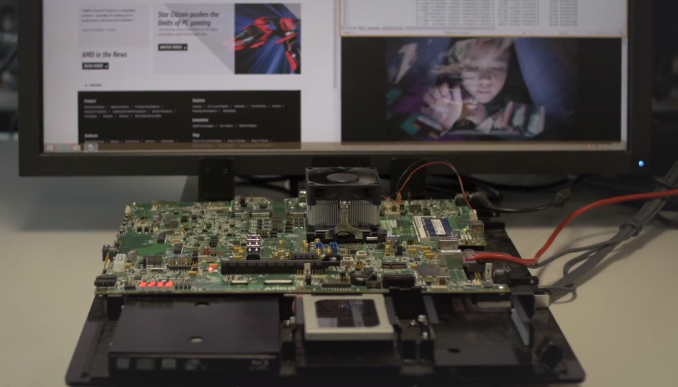
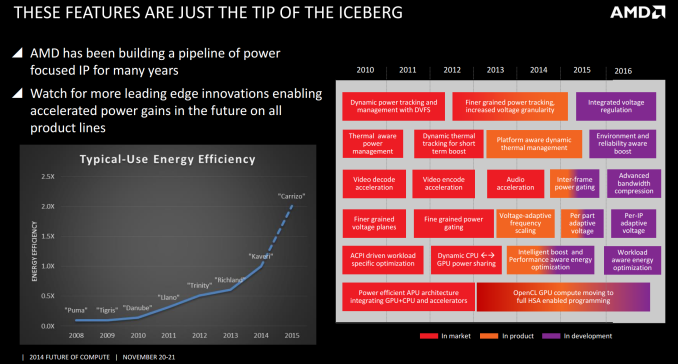
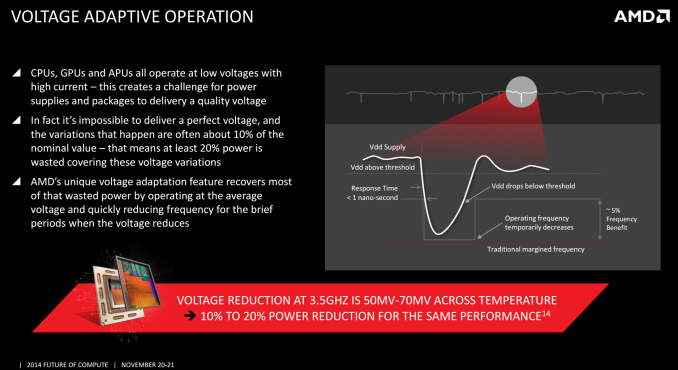
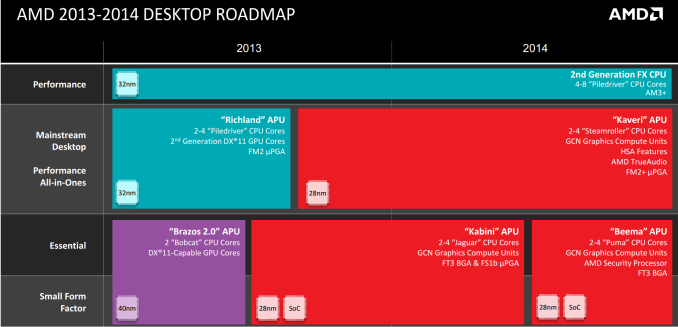








94 Comments
View All Comments
zepi - Thursday, November 20, 2014 - link
Considering that the competition is perfecting it's 14nm production with second generation products already out of the gates while AMD is still stuck with 28nm tells us everything we need to know about these chips.Where are the GDDR5 / DDR4 versions with fast enough GPU's that could actually run games? Or innovative mixed GDDR5 / DDR3 designs or edram/sram L4 cached versions?
Where is my 250W TDP highly clocked 4-core Steamroller with integrated 7970 class GPU, soldered to motherboard with enough edram / sram for framebuffer, 4GB of GDDR5 + two DDR3 sockets? Shipped with AIO water cooler? With clever driver programming to benefit from all the bandwidth and shared memory space with low level mantle api? The ultimate fusion of paraller- and serial computing power that became theoretically possible when AMD bought ATI?
Instead we have lousy bottom-to-middleclass CPU's with barely "good enough for Sims" GPU's that don't spark anyones interest. No deal AMD, No deal.
kyuu - Thursday, November 20, 2014 - link
As is usually the case, the low-wattage mobile variants are likely to be the most interesting. To my knowledge, Intel does not have Atom on a 14nm process, which is what those would be competing with. Insisting on continuing to compare these with Intel's Core line that cost significantly more is just silly.Of course, the issue is that, no matter how good AMD's chips are for mobile designs, they will continue to be ignored by OEMs and wont appear in anything but bottom-of-the-barrel designs. I wish something could be done about this, as I'd really love to get a table with an AMD SoC.
kyuu - Thursday, November 20, 2014 - link
Damn autocorrect plus lack of edit functionality; tablet, not table.mrdude - Thursday, November 20, 2014 - link
Part of earning trust is being on time, delivering on promises, and providing an enticing option. With respect to CPUs/APUs, AMD has failed on all accounts. Kaveri was delayed and so were Kabini and Temash. Worse yet, Kaveri showed up a fifth of its performance missing. Requiring high-speed dual-channel memory is required for the chips to shine, yet that also increases BoM and limits form factors.Personally, I can't believe they still haven't been able to produce an APU that can drive 1080p at high settings. Such a chip would sell like hot cakes, yet the company continually falters. What's the point of all of that GPU silicon if you can't utilize it? Do the CPU cores really need that much dark silicon? :P
Mikemk - Thursday, November 20, 2014 - link
The point is for smaller designs where a dedicated GPU wouldn't fit or would add too much heatmrdude - Thursday, November 20, 2014 - link
Yet their ramp for mobile Kaveris has been incredibly slow, and SFF NUC-like Kaveri and Beema/Mullins systems are nearly nonexistent.I understand the point. Speaking for myself, I'd love to buy an NUC system with an AMD APU inside that can drive 1080p. For that to happen, AMD still has to decrease power consumption, increase both CPU and GPU performance, cure the memory bottleneck, and actually get some of these products made so we're not chatting about hypotheticals. 2400mhz RAM on SO-DIMMs isn't going to happen, and that ~1.6v required to get there is too high. Even at 95W TDP Kaveri throttles the CPU down to ~3ghz when the GPU is under load.
I really don't think Carrizo is going to fix any of these issues. They might look a little better, but it's clear that nearly all of AMD's resources have been poured into their 2016 Zen and K12 architectures.
Gadgety - Friday, November 21, 2014 - link
SFF NUC-like, yes I've been looking for them, too. Surely this could be a segment of the market where APUs would fit. In the end I put together a 45W A8-7600 based Kaveri based M-ITX form factor but I'm surprised the kitbuilders haven't done so. I expect Carrizo to improve 10% on Kaveri, but much more. The Zen project is, as you say, where it's at.mickulty - Friday, November 21, 2014 - link
It doesn't make much sense to bash AMD over 'being on time' and 'delivering on promises' given what a complete dogs dinner broadwell and Intel's 14nm process has been. Remember when desktop broadwell was supposed to come out January 2014?mrdude - Friday, November 21, 2014 - link
Intel isn't the one attempting to persuade OEMs to use their chips.And I actually agree with you. Intel hasn't made an interesting processor since Sandy Bridge. Their Broadwell yields are still poor. But despite Intel being late and offering 5-10% improvements YoY, AMD still hasn't been able to claw back any ground.
The high end x86 space is an utter snoozefest.
andrewaggb - Friday, November 21, 2014 - link
yep